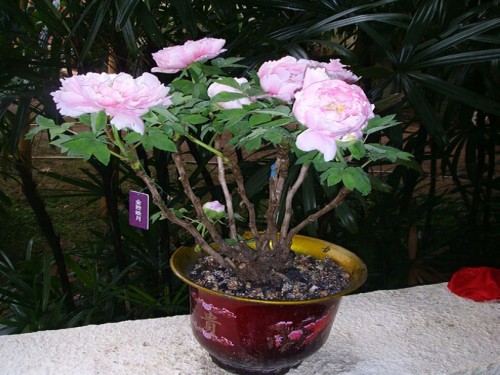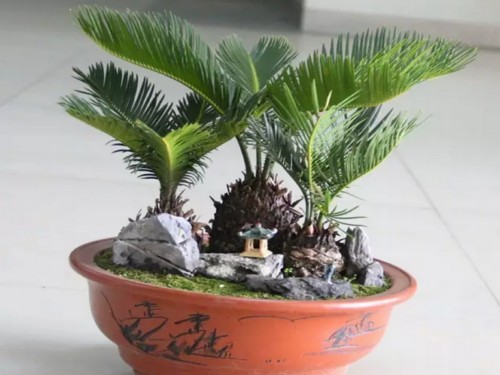Grafting technique of ornamental peony-grafting method of peony flower
China's peony export ranks first in the world, accounting for about 70% of the total. The export volume of Heze peony accounts for about 80% of the country's total exports, which is worthy of the name of the world's first peony distribution center. The export volume of peony and peony is about 3.5 million trees every year, of which peony accounts for about half. In the past two years when the whole landscaping industry is not very prosperous, ornamental peonies have been in short supply. In Heze, the planting volume and sales of ornamental peonies have increased significantly for two or three years in a row, and the local seedlings were almost sold out last year.
Peony is widely used in city parks, street green spaces, organs, schools, courtyards, temples, classical gardens and so on. With its colorful colors and beautiful decorative effect, it has become an important ornamental landscape in the garden. According to the principles of peony color and variety, we should plant regularly, choose varieties with similar color or the same plant height, pursue neat and consistent appearance, and plant them in pieces, forming a landscape of flowers and flowers, so that visitors seem to wander in a sea of flowers.

Grafting is the main method of breeding peony. Grafting can well retain the characters of the variety, and has the advantages of low cost, high speed, high reproduction coefficient, neat and standardized seedlings and so on. The main factors affecting the survival of grafting are grafting time, rootstock, scion and grafting method.
1. Selection of rootstock and scion
Scions should choose strong terminal buds or soil buds, as they are picked, and should not be released for a long time. If you can't use it up for the time being, wrap it in a wet cloth and put it in a cool place or bury it in the wet sand. The survival rate of grafting is closely related to the variety characteristics of scion. Precious peonies are often varieties that have good characters and are not easy to reproduce.
There are two kinds of rootstocks, namely, the roots of three-year-old seedlings of peony or peony, with a root thickness of more than 1 cm and a length of about 20 cm. Grafting peony with peony root is easy to operate, the seedling grows fast, but the root system is not very good; the operation of grafting peony with peony root is relatively difficult, but the survival rate of grafting is high, the root system of grafted seedlings develops well, and the plant grows vigorously.
2. Grafting method and time
The main results are as follows: (1) embedding method: mainly used for the grafting of peony root. The scion is embedded in the incision on one side of the peony root, the cambium is opposite, wrap the interface from top to bottom with hemp rope and paste it with mud.
(2) split grafting method: mainly used for the grafting of peony root. The main point of operation is to first cut the bottom of the scion into a thick and thin wedge, then split the dome of the rootstock with a grafting knife, insert the scion vertically, and finally wrap it with hemp rope.
Embedding and splitting are the most commonly used grafting methods, and the best grafting time is between late August and mid-October. The time of grafting is very strong, miss the best time, the survival rate of grafting is greatly reduced.
Bud grafting and grafting are mainly used to propagate 'assorted' peonies. The grafting time is from May to July and from August to September respectively. There are few practical applications in production.
3. Planting and management of grafted seedlings.
Grafted seedlings should be planted closely at the beginning, generally 40 to 50 centimeters between rows and 10 to 15 centimeters between plants. Before planting, rake the land first, use the trenching machine to open a planting ditch with a depth of 30 cm, and then put the grafted seedlings into the ditch, with the knife edge of the grafted seedlings 2 cm below the ground. Finally, fill the soil, compaction, rake the ridge on the planting line, and bury the scion 3 to 4 cm under the soil.
4. Organization and arrangement
Because the grafted peony has a short time and requires many items, it must be carefully planned, arranged and coordinated if you want to produce grafted seedlings in a large number of times in a short time.
5. Management after grafting
(1) budding in spring in the following year: as the rootstock sprouts in spring, which affects the growth of scion, it must be removed.
(2) after the peony branches spread their leaves slightly, the daily management of weeds and pest control should be removed. If the flower buds appear, they should be removed in time. The south of the Yangtze River generally does not need watering, if the soil is too dry, ditches can be opened to irrigate.
(3) the grafting of peony is usually one rootstock and one bud. After the second year of survival, if there is no flat stubble in autumn, the scion will only grow tall but not grow branches. Therefore, the one-year-old grafted seedlings that have survived should be cut from above the interface to stimulate the adventitious buds at the root buds to germinate branches. In this way, the 2-year-old grafted seedlings of tree peony can grow 2-4 short branches, carry out stubble pruning for two consecutive years and strengthen fertilizer and water management, which not only makes the grafted seedlings quickly reach the specification of coming out of the nursery, but also can be used as scions.
In many peony gardens in China, there are many architectural sketches, such as Peony Pavilion, Peony Hall, Peony Corridor, Peony Pavilion, Peony Xuan, Peony Fairy Sculpture, Peony Zhaobi, Peony murals and so on, which further exaggerates the theme of Peony Garden. Such as the Peony Corridor of the Caozhou Peony Garden in Heze, the Peony Corridor of the Shanghai Botanical Garden, the Peony Pavilion of the Huagang Guanyu Park in Hangzhou, and the statue of the lying peony fairy in the Peony Garden of the Beijing Botanical Garden, all endow the peony garden with subjective features and more charming artistic charm.
Time: 2019-06-10 Click:
- Prev

Sowing method of potted peony
Many flower lovers hope that there are many flowers and plants in their homes, and peonies are essential for watching bonsai, but the choice of potted peonies must also choose seedlings that are more suitable for potted plants in order to have ornamental value. So how to choose potted peonies? Although there are many varieties of peonies.
- Next

What kind of breeding does Cycas use?-Propagation methods of Cycas.
Iron tree originated in south-central China, India, Japan and Indonesia, and originated in East and Southeast Asia. Zhejiang, Jiangxi, Hunan, Sichuan and other places are widely cultivated; North China, Northwest China and other places as potted plants for indoor viewing. Cycads like sunshine, dry and ventilated environment, not cold-resistant, good fertilizer, like sandy soil, slow growth
Related
- Fuxing push coffee new agricultural production and marketing class: lack of small-scale processing plants
- Jujube rice field leisure farm deep ploughing Yilan for five years to create a space for organic food and play
- Nongyu Farm-A trial of organic papaya for brave women with advanced technology
- Four points for attention in the prevention and control of diseases and insect pests of edible fungi
- How to add nutrient solution to Edible Fungi
- Is there any good way to control edible fungus mites?
- Open Inoculation Technology of Edible Fungi
- Is there any clever way to use fertilizer for edible fungus in winter?
- What agents are used to kill the pathogens of edible fungi in the mushroom shed?
- Rapid drying of Edible Fungi

